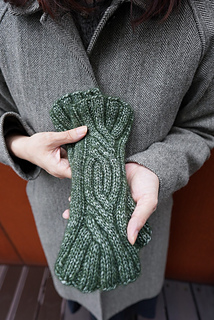patterns >  Regina Hwang's Ravelry Store
Regina Hwang's Ravelry Store
> Ready for the Laird











Ready for the Laird
The inspiration of this wrist warmer came from the television series Outlander. In season 1 episode 2 Castle Leoch, Claire was freshened and dressed up to be taken to the laird of the clan MacKenzie wearing a pair of hand-knitted wrist warmer.
As an Outlander fan, in celebration of the premiere of season 6, I’ve decided to re-publish my first ever knitting pattern now on Ravelry, written over seven years ago, back when Outlander first season was aired.
Ready for the Laird is a wrist warmer with 3 x 2 ribbing and cables. It’s quite a straight forward construction, easy to knit and adjust to personal preference. The slightly different cable bind-off is used to mirror the cable cast-on.
The wrist warmer is best showcased pairing with half or 2/3 sleeved sweaters.
The length is easy to adjust by knitting more or less plain ribbing rounds:
- To shorten or lengthen in scale - knit more or less rounds at the beginning, the middle and the end part of plain 3 x 2 ribbing. The number of rounds should be the same in all three parts.
- To lengthen just a little - knit few more rounds in the beginning and the end part of the 3 x 2 plain ribbing, and knit the middle part as the pattern instructed.
Blown yarns are particularly suitable for this project, if you want a smaller circumference, choose a thinner blown yarn and use needles one size smaller.
Besides Ilimani Amelie used in this re-published and first time on Ravelry version, Lana Grossa Alta Moda Alpaca is the yarn I used when I first wrote up this pattern. The result is very subdued and rustic. Another yarn I’ve used is Isager Alpaca 3, which will yield the result similar to Lana Grossa Alta Moda Alpaca but slightly sturdier.
It is suggested to use 2 cable needles, if you’re knitting cables without cable needles, then use 1 cable needle to help with the cables.
2139 projects
stashed
1654 times
- First published: March 2022
- Page created: March 5, 2022
- Last updated: April 23, 2022 …
- visits in the last 24 hours
- visitors right now




